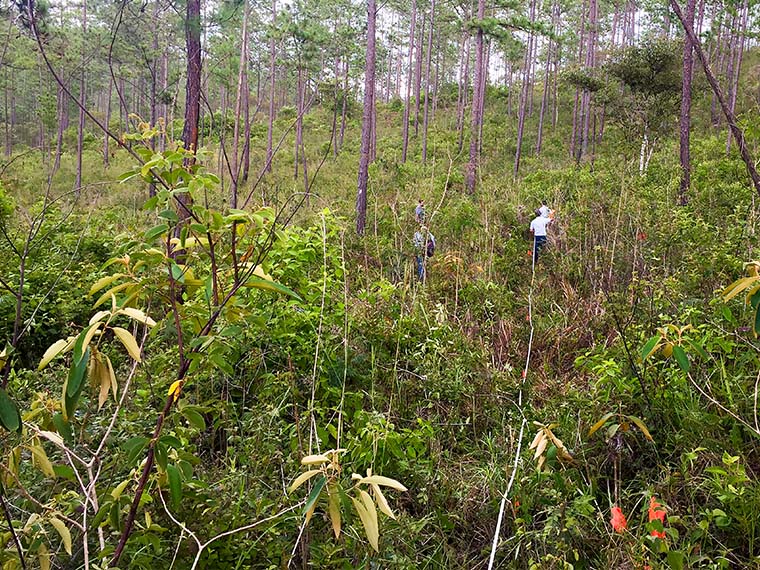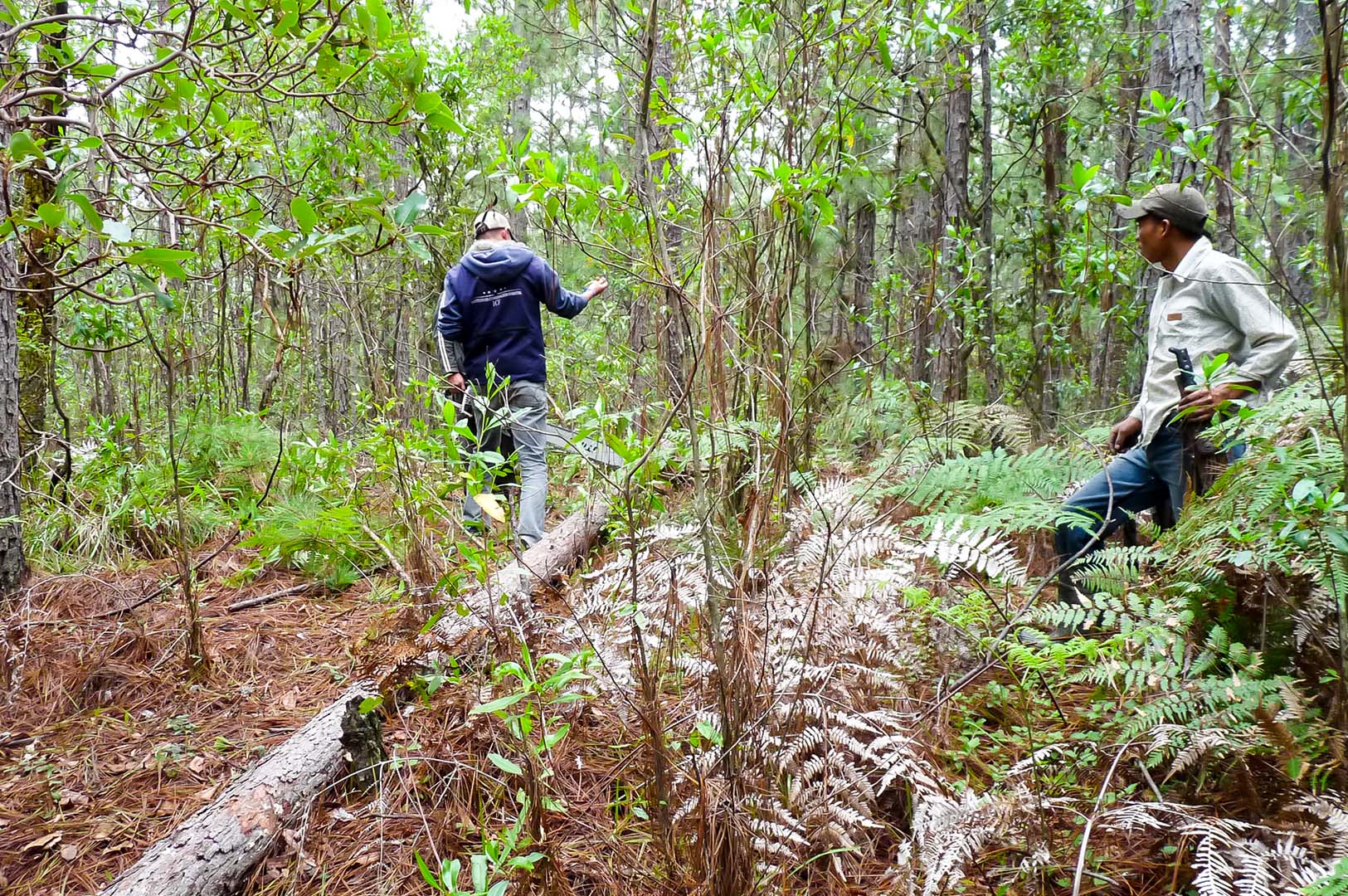The information presented on this page may be dated. It may refer to situations which have changed or people who are no longer affiliated with the university. It is archived as part of Mississippi State University's history.
Forestry is a $12.79 billion dollar industry in Mississippi so when pests like the southern pine beetle cause an outbreak it's a major cause for concern. Currently, the Magnolia State is experiencing its worst pine beetle outbreak in more than 30 years with more than 4,000 spots throughout the state's forests infested with the southern pine beetle. And the problem extends far beyond Mississippi. In places like Arizona, southern pine beetles are a threat to the health of the forest and people alike, increasing the likelihood of wildfires that potentially result in the loss of property and even life. In Honduras, where people depend on the forest for food, water, shelter, and their own livelihoods, a recent outbreak was so devastating the government mobilized the military and sent them into the forest with chainsaws. That's why researchers in the Mississippi Agricultural and Forestry Experiment Station are collaborating with scientists in the Forest and Wildlife Research Center to dig deeper into the big picture impact of southern pine beetle outbreaks.
Dr. John Riggins, associate professor in the Department of Biochemistry, Molecular Biology, Entomology and Plant Pathology, explained that pine beetle outbreaks can potentially be both a symptom and cause of climate change.
"Worldwide, we are seeing more frequent and severe forest pest outbreaks in general but pine beetles, in particular, seemed to be linked to climate change," Riggins said, noting that the pests have recently been trapped as far north as Connecticut and were also responsible for a recent outbreak in New Jersey. "Trends like these could possibly be driven by climate change. As the climate becomes more variable, we tend to have more pine beetle outbreaks, which in turn, could cause entire forests to shift from carbon sinks to carbon sources."
Riggins said that while forests are the largest potential terrestrial carbon pools, mid-latitude temperate forests like the ones in Mississippi are minor carbon sinks (meaning that most of the carbon produced by decaying trees currently stays in the system as opposed to being released into the atmosphere).
"It wouldn't take a lot to convert these forests into carbon sources. Any type of disturbance that changes how carbon is being stored and released in the ecosystem can have big implications on whether these forests are carbon sinks or sources in the future," Riggins said.
Riggins' team is studying the relationship between southern pine beetles, blue stain fungus and subterranean termites. Riggins said the relationship is significant because pine beetles and termites are considered keystone species, which drive the structure and function of an ecosystem through their activities. The effects of these keystone species work in a linear fashion, with the actions of one species influencing the next and so on.
"Pine beetles are oftentimes the most important herbivore in a pine ecosystem. Their presence can change the structure and dynamic of a forest. Similarly, termites are the most important decomposer invertebrates that break down a system and by their presence and activity, they drive a forest's carbon cycle dynamics," Riggins said.
The team set up an initial test site of a simulated pine beetle attack on 37 forested acres of the John W. Starr Memorial Forest in Winston County, Mississippi in the summer of 2015 to investigate the pest's impact on forest carbon storage and cycling. They determined that some termite species preferentially feed on wood from bark-beetle-killed trees. The scientists narrowed the preference down to the presence of certain fungi called blue stain that is carried by eight-legged mites that live on the pine beetles.
Researchers then sought to discover how widespread this relationship was in climates outside of Mississippi. The study now includes sites in Flagstaff, Arizona, and Siguatepeque, Honduras, two climates that harbor unique risk factors.
At each site, the researchers are collecting data on felled trees in the forest that are naturally infested with pine beetles alongside felled healthy trees. They have caged individual wood sections in different ways so they can study the impact of above- and below-ground invertebrate, fungi, and microbes in isolated settings. They will then measure woody decomposition at year one and year two and determine how each species contributes to the breakdown of wood. Additionally, they are measuring the carbon and nitrogen in and around the tree, including the carbon that is being released into the atmosphere from the wood and the soils. Researchers hope the sites will show them the prevalence of the interspecies interaction across different climates between different subspecies of pine beetles and termites.
"Right now all of our evidence is based on species in Mississippi. If we determine that this relationship exists among bark beetles, blue stain fungi, and subterranean termites elsewhere in the world, it could mean we are underestimating the rate at which wood decomposes following bark beetle outbreaks," Riggins said. "It could also help explain why there is so much variability in the rate of woody decomposition that climatic variables don't account for."
Dr. Courtney Siegert, assistant professor in the Department of Forestry, is assessing how the interactions influence the hydrology and biogeochemistry of each site.
"Terrestrial carbon models incorporate a numerical value for woody decomposition and a lot of times there is a high degree of variability that is unexplained by climate data," Siegert said. "We hope to explain part of that variability using biological interactions between decomposer organisms."
Currently, models for forest decomposition don't factor in the biological influences of invertebrates, fungi, or microbes.
"All of the current models use temperature and rainfall to predict the rate of turnover, which is critical in determining whether carbon is released back into the atmosphere or incorporated into the terrestrial carbon pool," Siegert said. "We hope that by understanding the role decomposers play, we can improve our predictive capability in determining how a forest stores and cycles carbon."
The project's other co-investigators are Dr. Natalie Clay of Louisiana Tech University and Dr. Juliet Tang of the U.S. Forest Service Forest Products Lab. Collaborators include Oscar Leverón of Universidad Nacional de Ciencias Forestales and Dr. Richard Hofstetter of Northern Arizona University. Funding has been provided from the National Science Foundation with added financial support from a MAFES Special Research Initiative grant and both the College of Agriculture and Life Sciences' and College of Forest Resources' Undergraduate Research Scholars Programs. Additional funding is provided by the MSU Department of Biochemistry, Molecular Biology, Entomology, and Plant Pathology; the Institute for Genomics, Biocomputing and Biotechnology; the Forest and Wildlife Research Center; and the Office of Research and Economic Development.


